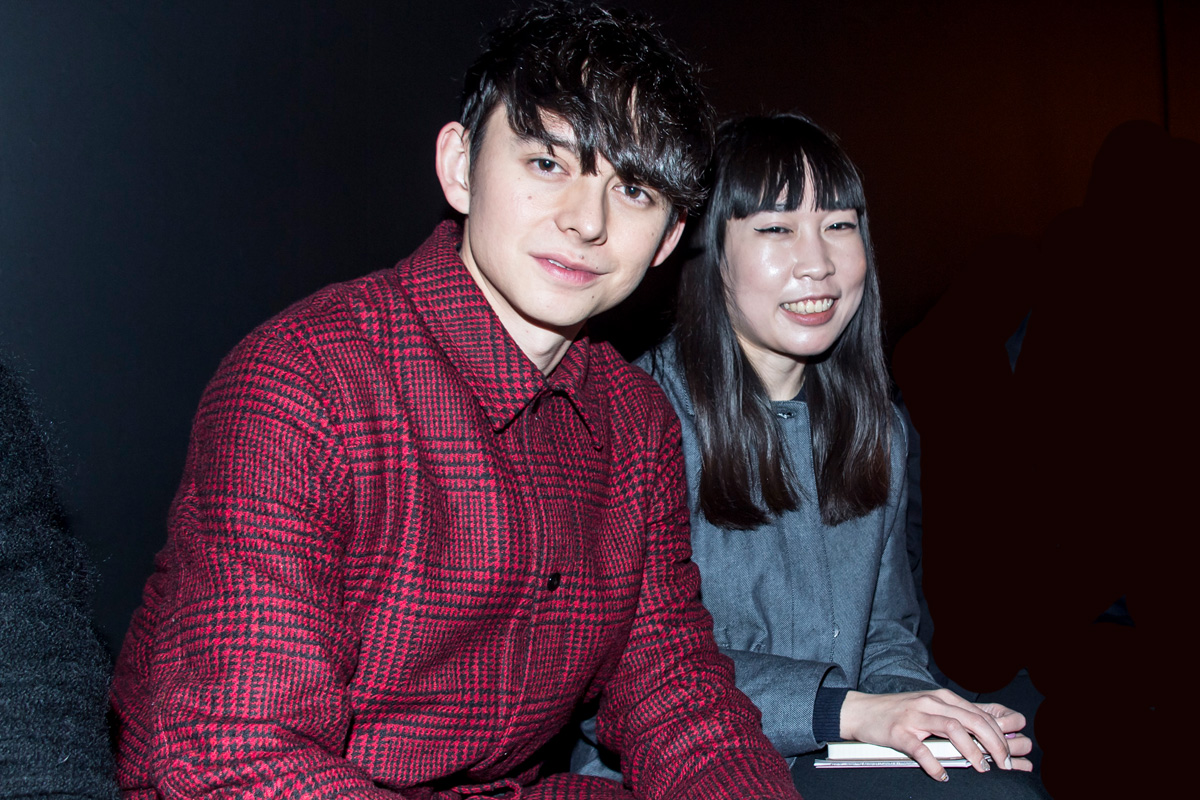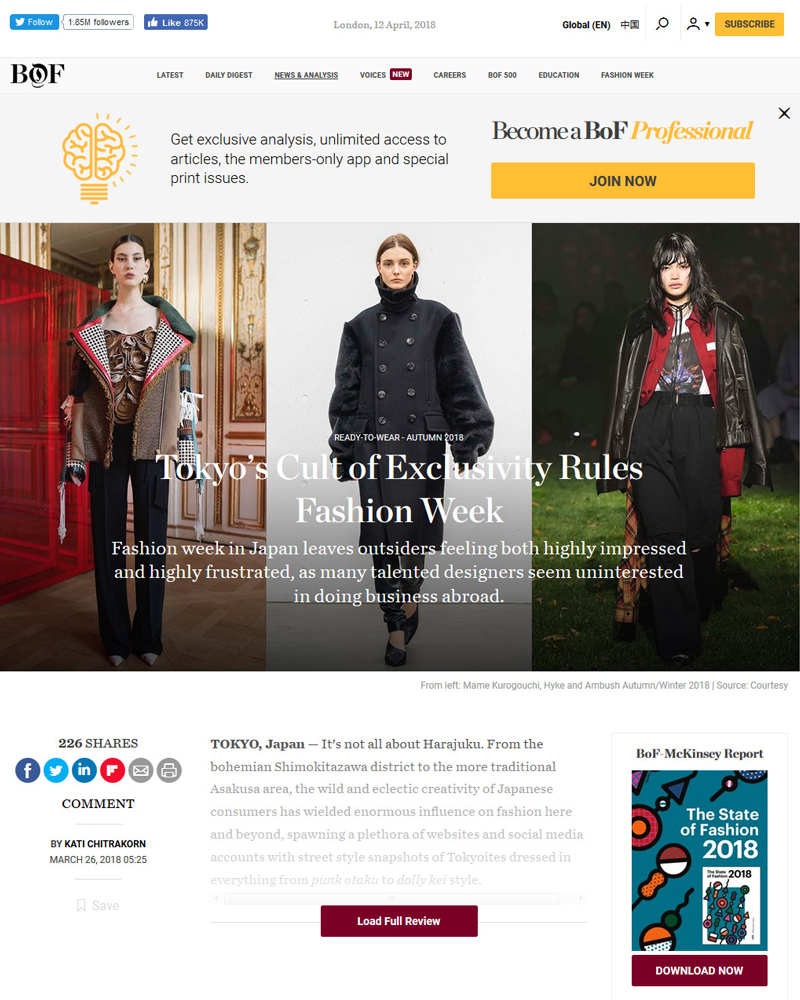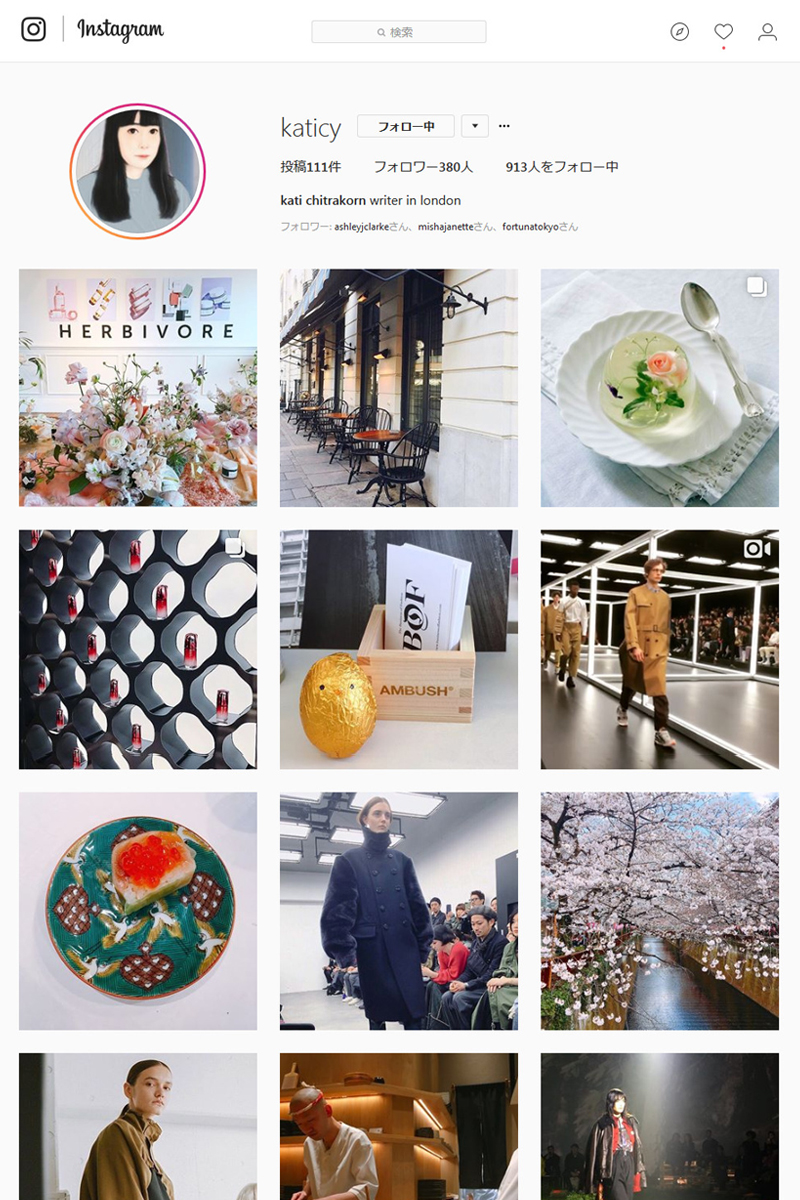Kati Chitrakorn
AmazonFWT 2018 A/W Overseas Guest Interview vol. 1
Kati Chitrakorn is a senior reporter at The Business of Fashion, covering the intersection of fashion and business, with a focus on Asia-Pacific. She has recently written about China's luxury acquisitions, reporting on investments by Fosun, Shandong Ruyi and Yu Holdings. She is also focused on expanding global beauty coverage. Before joining BoF, Kati worked for Women's Wear Daily and the International New York Times. Born in Bangkok and raised in Hong Kong, she has a bachelor's degree in journalism from the London College of Communication.
Kati Chitrakorn:
[ Instagram ] https://www.instagram.com/katicy/
[ Twitter ] https://twitter.com/katicy_
The Business of Fashion:
[ Website ] https://www.businessoffashion.com/
[ Instagram ] https://www.instagram.com/bof/
[ Twitter ] https://twitter.com/bof
[ Facebook ] https://www.facebook.com/businessoffashion
Ms. Kati Chitrakorn of “The Business of Fashion” (BoF, hereinafter), visited Japan during the Amazon Fashion Week TOKYO A/W term. BoF was started in 2007 as a personal blog of its founder, Mr. Imran Amed, which, by today, has grown into a media gathering passionate attention from people in the fashion business around the world. We’ve talked to Ms. Chitrakorn, their Senior Reporter, on a variety of themes, including her impression of the fashion week in Tokyo, the attractions and problems of Japanese brands, the Asian beauty market which is one of her fields of expertise, etc.
We’ve heard you’ve been in Japan several times.
Yes. I’ve been here 3, 4 times in private. But this is my first time to be here on business, so I was very excited when the visit was determined. Japanese fashion is exciting, and I’ve been a long-time fan. The invitation came at a time when BoF was thinking of focusing more attention on Asian business, so this was a very good opportunity.
Please tell us your impression of Japanese fashion, and/or the town of Tokyo.
I think the attention to detail and thoughtfulness in Japanese shops and restaurants is wonderful, and that Japan is a country exceeding in customer service. As for Tokyo fashion, I think it is extremely unique in the sense that it is not overly influenced by trends, so it’s easily understandable why fashion magazines and creators from around the world are inspired by Tokyo. On the other hand, although this is not unique to Tokyo but rather, happening around the world, I have the impression that Tokyo fashion has become flat compared to before, due to the rise of fast fashion.
Haven seen the Tokyo fashion week, what is your impression?
I’ve been going to the fashion week in London, but in comparison, in Tokyo there is a sense of excitement, an element of surprise of not knowing what may pop out, which is very fun. Participants of the London fashion week is mainly big Maisons, whereas in Tokyo fashion week, there is a diversity, not only in the participating brands, but also in the music, production and models in the shows, which gave me the impression that it is a bit ahead of collections in other cities.
Of the runway shows you’ve seen so far, are there any brands which left an impression?
The moderately trendy designs and use of colors was wonderful in the first show I saw, FREIKNOCK by a Korean designer, and the quality of each piece was high, so I remember it well. It was wonderful how aspects of traditional craft were sublimated in a way to fit modern women in the collection by Mame Kurogouchi, whom I’ve been following for the past few years, and I think Ms. Kurogouchi is one of the designers suited to represent Japan from hereon. I also thought AMBUSH® was extremely good. The collection itself was wonderful of course, but the line-up of guests visiting the show is both interesting and important in a fashion show, and I saw influential guests such as Hiroshi Fujiwara and Kiko Mizuhara at this show.
Please tell us about BoF, which you belong to.
BoF started in 2007. Thanks to a financing in 2012, we were able to hire key personnel, by which we were able to complete its present structure as a fashion media. Conventionally, fashion medias were either commercial geared towards BtoC, such as ‘VOGUE’, or industrial BtoB, such as ‘WWD’, but we stand in the middle of both without leaning towards either, and it is our principle to highlight those people whom remained behind the scenes up to now, to convey the truth on how the fashion industry is structured and how things work. The range of our readers is extremely wide, ranging from young people hoping to work in the fashion industry, to executives hoping to expand business. We provide free career and/or educational articles for our young readers, and charged in-depth articles on the industry, so all our readers can find something of interest.
Please tell us of your role at BoF, and topics you are especially focused on, if any.
I joined BoF in 2015, and presently, as a member of the editorial team, I’m mainly in charge of the Asian beauty market. Through my work, I’ve done interviews into the background of big international beauty brands such as Shiseido changing their brand developments both domestically and internationally, and I find it extremely interesting how they focus brand strategy according to each countries culture and/or trends. For example, even the idea behind putting on make-up is very different between Western countries and Asia. Japanese prefer make-up with a natural look, while they spend time and effort on their hair, like curling it every morning. Whereas in Western cultures, people put on make-up to make a created-look, but don’t spend time or effort on their hair. Such cultural differences are not only interesting, but makes one realize how important it is in the fashion business to understand consumers.
These are times in which everybody and anybody can easily access information through SNS, etc. In such times, what sort of role do you think is being demanded of fashion medias?
I think it is extremely important to have a unique point of view. Presently, BoF transmits charged articles also, but at the beginning, we were all worried that nobody would want to pay to read our articles. But in truth, our charged articles are very popular among our executive readers, which made us realize a sure demand for in-depth articles found nowhere else. Also, recently at BoF, our employment platform is gathering popularity. Although it is still only a few, our education courses in which people can gain certificates, and conferences inviting knowledgeable people from all sorts of industries to probe into possibilities for new business, is also received very favorably. We think the importance of such activities besides transmitting articles, will increase in the future.
How is the reaction towards Japanese fashion and/or beauty related articles among the readers of BoF?
It’s extremely good. There are many brands which are popular among our readers, and I think many Japanese brands have a higher global acknowledgement than most Japanese realize. On the other hand, for many people, Japan is still a country of many mysteries, so there is still much room to raise acknowledgement. At BoF, we intend to continue paying attention not only to Western markets, but also to Asian markets, including Japan, China, India, etc.
For Japanese brands to appeal to overseas markets, what do you think is necessary?
Modest and humble by cultural nature, Japanese brands tend to be modest compared to overseas brands. But the level of quality of the things you make are so good, I think you should assert yourselves a little more. Overseas designers actively utilize SNS such as Instagram, but comparatively speaking, I think Japanese designers and brands are a bit too discreet, and from the point of view of raising acknowledgement of the brand, I think well thought-out collaborations such as sacai did, are needed more. Furthermore, there still seems to be a sense of taboo among Japanese designers to place importance on commercial rather than artistic qualities. In the background of this, I think there is a stereotype of commercialism being bad, but before anything, I think they need to get rid of this mentality. As a matter of fact, brands such as Mame and HYKE have been announcing fabulous collections apt in both design and commercial. On the other hand, Japanese brands are very good in fusing old things with new things, which is a forte I hope they will continue to nurture.
INTERVIEW by Yuki Harada
INTERPRETATION by Aiko Osaki





